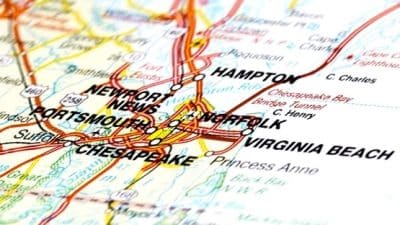
Funded by the USDA Forest Service’s Southern Region, the GIC and the states were awarded funds to provide cities with technical assistance to determine how their trees reduce runoff.
The Virginia Department of Forestry is the Virginia partner on the project.
Eleven cities and one county were selected to participate. They include localities of large, medium and small densities and are found in the mountains, the piedmont and the coastal plain. In Virginia, the study mapped the urban canopy for Lynchburg, Harrisonburg and Norfolk. Participating localities are innovators for effective, greener stormwater management. There is a case study booklet for each pilot locality detailing the project, methodology, lessons learned and best practices for other cities who wish to do this work.
Excessive stormwater runoff accounts for more than half of the pollution in America’s surface waters and causes increased flooding and property damages as well as public safety hazards. National studies indicate that land conserved for stormwater retention and flood prevention “show an eight-to-one dollar savings ratio versus man-made flood-control structures” (McDonald 2015). Cities need to better integrate trees into their stormwater management programs.
Cities suffering from standing water and urban flooding now have a key tool in their arsenal to reduce this runoff and clean surface waters! One urban tree can soak up thousands of gallons of water annually and clean the water too. Yet many cities have not mapped their trees and don’t understand how to utilize them to prevent urban runoff. Trees lost to storms and development should be replaced and new trees can be planted to provide many benefits.
The results demonstrate how any city can use this approach to map their canopy and model the role trees play in intercepting and cleaning the runoff. Trees can filter out nitrogen, phosphorus and sediment – three key pollutants harming Virginia’s surface waters. For example, during an average high volume rainfall event in Lynchburg (a 10-year storm), over 24 hours the city’s trees take up an average of 70 million gallons of water. That’s 105.4 Olympic swimming pools of water! The calculator tool allows any city to plug in tree canopy data and learn how trees soak up water and how many more can be planted. It also shows how much more water will runoff if trees are lost.
There is also a policy assessment tool to determine if city policies are making the city more impervious and also how they can improve urban forest management – cities can administer this tool to grade themselves and see how to improve and community groups can also rank their cities. The case books, summary report and tools can be found on GIC’s website at http://www.gicinc.org/trees_stormwater.htm
Valuing the benefits of the urban forest helps us to better understand the contribution of trees to the ‘ecosystem services’ that trees provide such as cleaner water, air, shade, stormwater uptake and aesthetic values. According to the GIC’s Director Karen Firehock “Decisions about our urban forests are made every day by homeowners, developers and city planners. Everyone should understand that when we lose trees, we may be increasing flooding and water pollution. We need to understand where to conserve trees and where to plant new ones to reduce urban flooding.” Maps provided to the cities show where trees take up the most water and where trees can be planted now to soak up even more water and the water pollution benefits of doing so.










